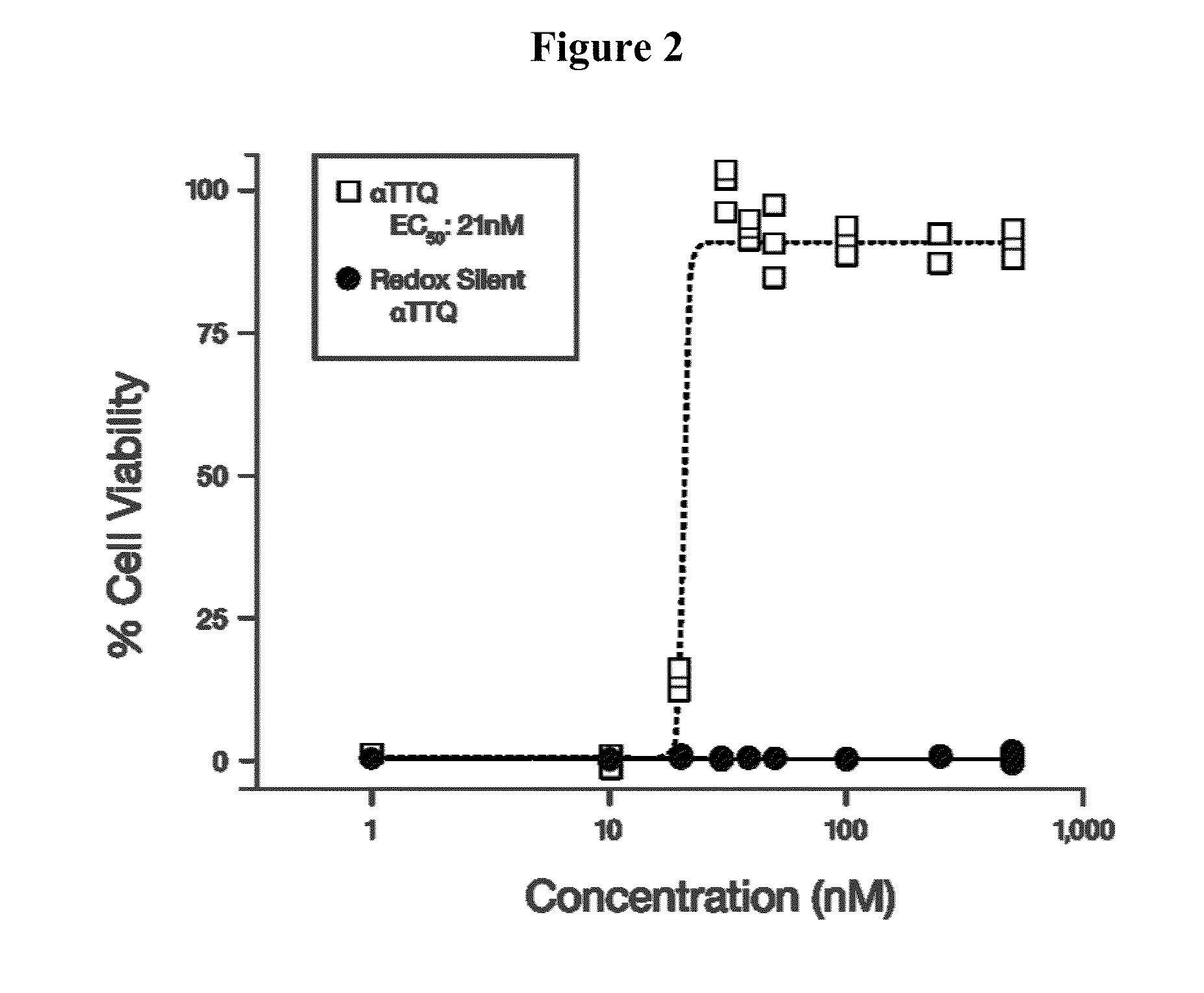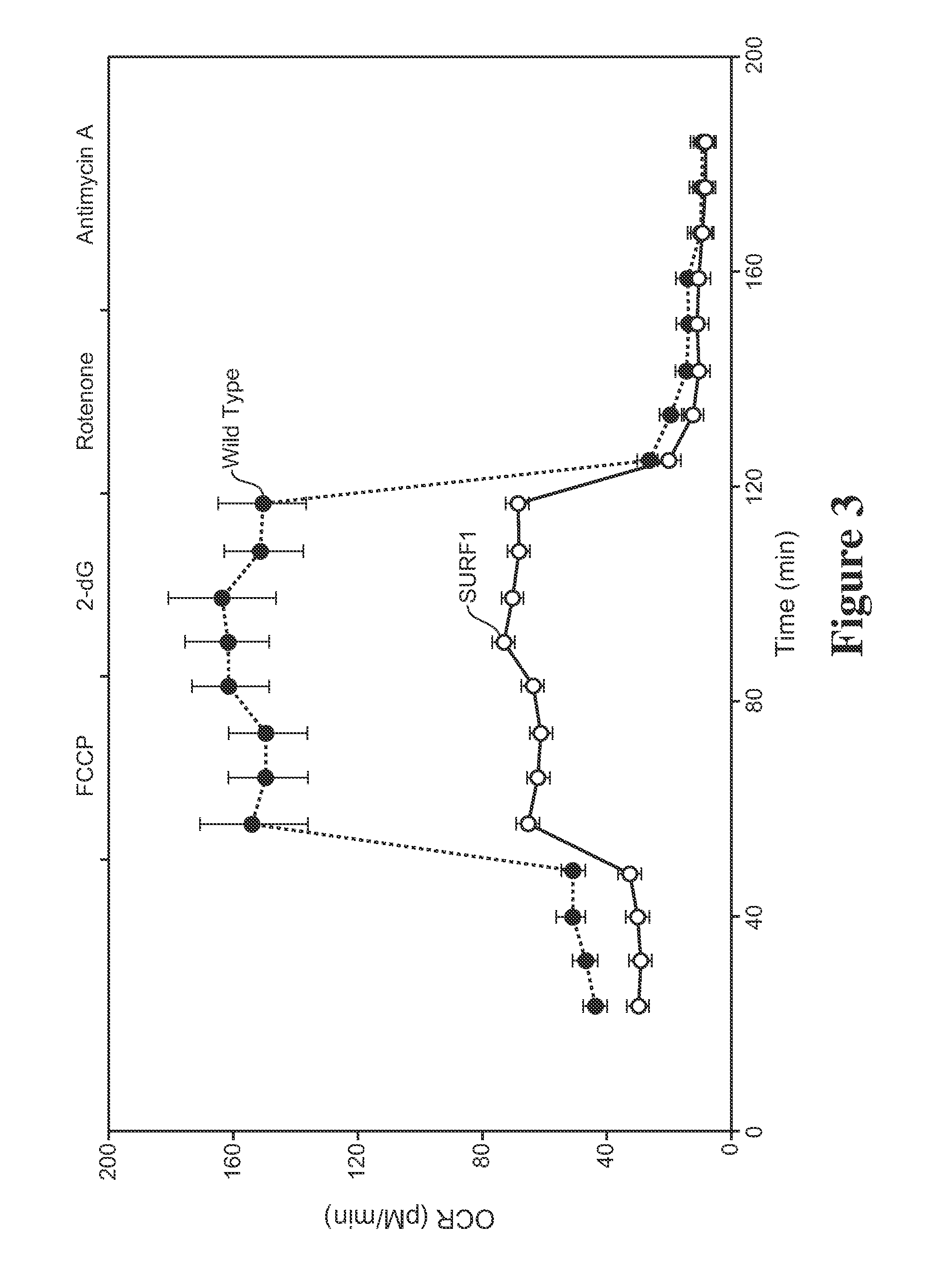Treatment of leigh syndrome and leigh-like syndrome with tocotrienol quinones
a tocotrienol quinone and leigh syndrome technology, applied in the field of treatment of leigh syndrome and leighlike syndrome with tocotrienol quinones, can solve the problems of extremely poor prognosis of patients with leigh syndrome and unfavorable treatment
- Summary
- Abstract
- Description
- Claims
- Application Information
AI Technical Summary
Problems solved by technology
Method used
Image
Examples
example 1
Surfeit-1 (SURF1) Cell Line Assay and Initial Screen for Effective Compounds
[0133]Alpha-Tocotrienol quinone, its redox-silent version (the bis-Boc protected corresponding hydroquinone), and solvent controls were tested for their ability to rescue cells from SURF-1 fibroblasts of the patient diagnosed with SURF-1 described in Example 2, when the cells were stressed by addition of L-buthionine-(S,R)-sulfoximine (BSO), as described in Jauslin et al., Hum. Mol. Genet. 11(24):3055 (2002), Jauslin et al., FASEB J. 17:1972-4 (2003), and International Patent Application WO 2004 / 003565. EC50 concentrations of test compound and its redox-silent version were determined and compared. The following compound, 2-((6E,10E)-3-hydroxy-3,7,11,15-tetramethylhexadeca-6,10,14-trienyl)-3,5,6-trimethyl-bis(t-butyloxycarbonyl)benzene-1,4-diol, the bis-Boc protected hydroquinone form of alpha-tocotrienol quinone, was used as the “redox-silent” alpha tocotrienol quinone, or αTTQ-RS.
[0134]MEM (a medium enriche...
example 2
[0144]Treatment of a Leigh Syndrome Patient Diagnosed with Surfeit-1 (Surf-1) Mutation
[0145]A four-year-old female patient with Leigh Syndrome was treated with alpha-tocotrienol quinone. Informed consent was obtained from the child's parents in accordance with federal regulations and institutional protocol. Two mutations were identified in the SURF-1 gene of the patient.
[0146]The patient's weight was approximately 10 kg. Alpha-tocotrienol quinone was administered to the patient via gastrointestinal feeding tube; the drug was mixed with sesame oil for administration. The following dosing of alpha-tocotrienol quinone was used:
Days 0-5: 0 mg
[0147]Days 5, 7-20: 32 mg (3.2 mg / kg)
Days 20, 22-50: 80 mg (8 mg / kg)
Days 50, 52-80: 120 mg (12 mg / kg)
Days 80, 82 and continuing: 200 mg (20 mg / kg)
[0148]The day after each increase in dosage, no dose was administered, and laboratory tests were performed to evaluate the effect of the increased dosage on clinical markers.
[0149]Full pharmacokinetic samp...
example 3
Treatment of a Leigh Syndrome Patient
[0170]A 4-year-old male patient with Leigh Syndrome was treated with alpha-tocotrienol quinone. Informed consent was obtained from the child's parents in accordance with federal regulations and institutional protocol. A mutation was identified in the SURF-1 gene of the patient.
[0171]At the start of treatment, the patient was unable to control his extremities. After 22 days of treatment, the boy was able to move his arm in the “high-five” gesture. Gastrointestinal function was greatly improved, and sleep was improved. The patient also gained weight. After 379 days of treatment, the patient had gained 15 pounds, was able to sit upright, rode on a horse with assistance, and started kindergarten.
PUM
| Property | Measurement | Unit |
|---|---|---|
| concentration | aaaaa | aaaaa |
| concentration | aaaaa | aaaaa |
| concentration | aaaaa | aaaaa |
Abstract
Description
Claims
Application Information
 Login to View More
Login to View More - R&D
- Intellectual Property
- Life Sciences
- Materials
- Tech Scout
- Unparalleled Data Quality
- Higher Quality Content
- 60% Fewer Hallucinations
Browse by: Latest US Patents, China's latest patents, Technical Efficacy Thesaurus, Application Domain, Technology Topic, Popular Technical Reports.
© 2025 PatSnap. All rights reserved.Legal|Privacy policy|Modern Slavery Act Transparency Statement|Sitemap|About US| Contact US: help@patsnap.com



